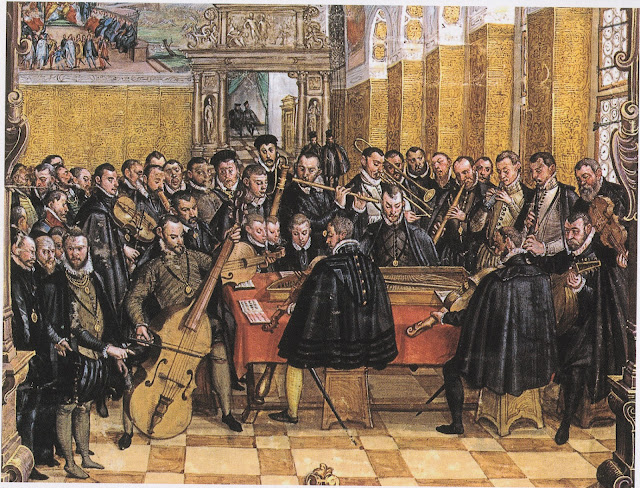 |
| Orlande de Lassus and the Bavarian court musicians, circa 1563-70 by Hans Mielich (1516-1573) |
Masters of Imitation: Lassus, Casulana, Josquin, Châtelet, Bob Chilcott; The Sixteen, Harry Christophers; Old Royal Naval College Chapel, Greenwich
Reviewed 10 September 2024
Lassus’ endlessly inventive and imaginative music in a programme that showcased 16th century composers’ fascination for basing new works on existing material
The Chapel at the Old Royal Naval College in Greenwich dates from the early 18th century, built to Sir Christopher Wren’s designs, but its interior is rather later, being rebuilt in 1779 following a fire by James ‘Athenian’ Stuart. Regarded as one of the finest neo-Classical interiors of the period it might seem an incongruous setting for a programme of 16th century music but Stuart’s combination of richness, formality and artifice proved just the right backdrop for the Sixteen’s programme of music founded on that example of very 16th century musical artifice, parody.
Tuesday 10 September 2024 was Harry Christophers and The Sixteen‘s latest stop on their 2024 Choral Pilgrimmage, Masters of Imitation, a tour that encompasses 20 concerts in seven momths, along with eight choral workshops. The programme featured pieces linked by a web of influences and connections. Lassus’ motet Osculetur me osculo oris sui, setting the song of songs, and the Credo from his mass based on it, Missa Osculetur me. Josquin’s Benedicta es caelorum, Lassus’ Magnificat Benedicta es caelorum Regina based on it and Jean Guyot de Châtelet’s remarkable Benedicta es caelorum where he adds extra voice parts to Josquin’s motet. There was the plainsong psalm Lauda Jerusalem Dominum and Lassus’ motet that uses it, Lauda Jerusalem Dominum, and even more complex, Bob Chilcott‘s Lauda Jerusalem Dominum, commissioned for the tour, which used the same text but was a parody of Lassus madrigal Cantai, or piano.
There was also Lassus’ Salve Regina, along with two madrigals by Lassus’ contemporary, Maddalena Casulana, and we know that her music was performed at the festivities for a ducal wedding in Munich that Lassus supervised, so the web of connections was completed.
With this style of music, we are not necessarily meant to perceive the complexity of the mechanism, instead we are often presented with textures whose sheer richness masks the more formal structure, the composer displaying their skill with the sheer inventiveness with which the original was used.
The evening began with the plainchant Lauda Jerusalem Dominum sung with elegance and clarity by the sopranos and tenors of the choir, This was followed by Lassus’ double-choir motet Osculetur me osculo oris sui where we have to do a lot of casuistry to turn a text full of phrases like ‘Let him kiss me with the kiss of his mouth’ into something religious, but Lassus creates music that combines unparalleled richness with a harmonic inventiveness that echoes Gesualdo.
By contrast Maddalena Casulana’s madrigal Morir non puo il mio core was poised and perhaps slightly cool, the words articulated strongly but this was a choral performance of a work probably written for four highly emotional performers.
We returned to Osculetur me with the Credo from Lassus’ mass based on the motet. What struck me was how Lassus’ deft writing (for double choir) managed to combined a texture full of swinging cross rhythms with a clarity of articulation so that the words were clear (something of importance in the creed). The ‘Et incarnatus’ kept the strong rhythms but in a slower texture which had a sense of harmonic stasis whilst the ‘Crucifixus’ was surprisingly intricated, yet the textures transparent. We ended with the vivid rhythms of the opening leading to an exciting finish.
Josquin’s Benedicta es caelorum made a wonderful contrast. The motet was printed a year before Josquin’s death in 1521 and the sound world is stronger and more austere than that of Lassus. Here we had quite a strong feel for the plainchant sequence passing through the texture with multiple lines and different speeds of articulation around it, yet the space and strength were all Josquin’s own. A remarkable and fabulous experience.
Lassus’ madrigal Cantai, or piango came next, included because it formed the basis for Chilcott’s piece which ended the programme, but providing a nice pair with the Casulana. We got to experience Lassus wonderful shifting harmonies, and this was beautifully performed, though again it was a choral version of a more intimate work.
The first half ended with a return to Lauda Jerusalem Dominum with Lassus’ six-voice motet based on the plainchant squence. This was rich and vigorous polyphony, with plenty of vivid rhythms, though Lassus provided a nice contrast for the third section where we boiled things down to just two soprano lines and one tenor line, though the lines themselves were strong and the results striking.
After the interval we returned to Josquin’s Benedicta es caelorum but in a version by Franco-Flemish composer Jean Guyot de Châtelet which was a prime example of another form of imitation, this time si placet where the outlines of the composer’s original are kept and another composer adds extra lines. Here, Châtelet added six new voice parts to Josquin, the result was astonishing. A very different atmosphere to the original with lots of highly mobile lines cascading over each other, all elegance and richness.
Lassus’ six-part Salve Regina was not linked to any of the programme’s web of inferences but the work needs no excust. Poised richness and discreet grandeur, it was a gorgeous small piece yet full of highly imaginative and effective moments.
We then returned to Maddalena Casulana with her madrigal, Vagh’amorosi augelli, sung by just eight voices in a wonderfully intimate manner, all light and fleet.
Lassus based his Magnificat Benedicta es caelorum Regina on Josquin’s motet, alternative plainchant and polyphony to striking effect. Initially the polyphony was exuberant and fleet, with lovely textures, later becoming positively invigorating, but other polyphonic sections boiled things down to just three voices, creating some remarkable moments in a striking work.
We ended with Bob Chilcott’s Lauda Jerusalem Dominum, setting the words of the Latin sequence but using Lassus’ madrigal Cantai, or piango, as its source. Chilcott uses several harmonic sequences from the madrigal, but the soundworld of the final work is all Chilcott’s own. The opening was appealingly upbeat with warmly opaque harmonies, and throughout the work there were a variety of appealingly imaginative textures, often with multiple flowing lines around a slower contrasting onw. This was polyphony but with a modern touch and very much with its heart on its sleeve.
The blog is free, but I’d be delighted if you were to show your appreciation by buying me a coffee.
Elsewhere on this blog
- L’Olimpiade: Vache Baroque makes an engaging case for Pergolesi’s penultimate opera – opera review
- A subtle depiction of a complex man: Green Opera’s 555, Verlaine en prison at Grimeborn – opera review
- Scaling the peak: David Skinner on recording Byrd’s The Great Service with Alamire reflecting new ideas about pitch and scoring – interview
- Discovering Imogen: A relatively underrated British composer, Imogen Holst is put centre stage in this brand-new recording on NMC – record review
- Exquisite vocal lines & imaginative storytelling: Harry Christophers & The Sixteen focus on Stanford’s secular choral music in Partsongs, Pastorals and Folksongs – record review
- Music of a Silent World: Chanticleer in an eclectic recital exploring the natural world – review
- A Road Less Travelled: in advance of its London premiere, Alec Roth discusses his 2017 song cycle to poems by Edward Thomas – interview
- Drawing you in: Ensemble OrQuesta combined physical theatre with comedy & a sense of anger in Mozart’s Le nozze di Figaro at Grimeborn – opera review
- To Lviv with Love: Paul
Mann combines conducting in the Ukraine with investigating neglected
composers for Toccata Classics, including the Swiss composer Richard
Flury – interview - Prom 52: Intelligent, vivid & satisfying account of Bizet’s Carmen from Rihab Chaied, Evan LeRoy Johnson, Anja Bihlmaier at Glyndebourne’s visit to the BBC Proms – opera review
- Home








